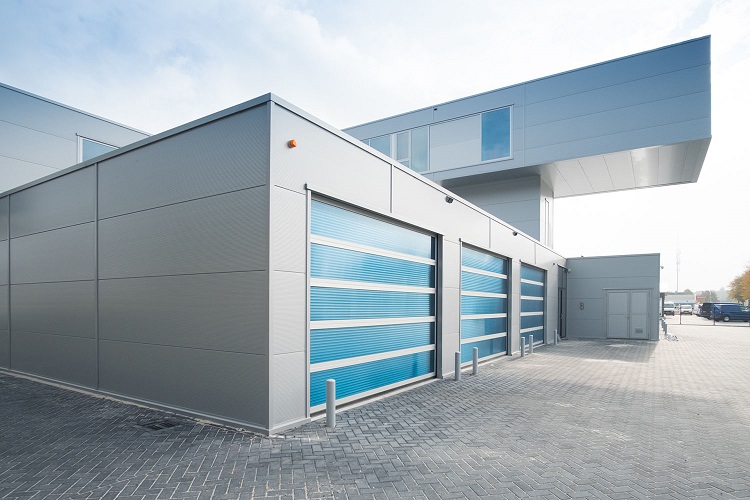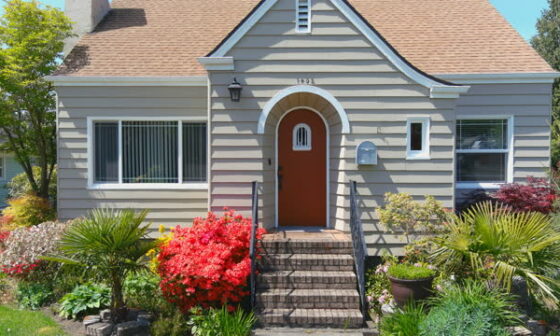
Sectional overhead doors are large doors used to cover openings on industrial buildings, warehouses, garages, and other commercial facilities. These doors are made up of several horizontal sections hinged together that allow the door to roll up vertically into a compact space when opened.
Sectional overhead doors provide several advantages over traditional single-panel “up and over” doors and are a popular choice for commercial and industrial applications in the UK.
How do sectional overhead doors work?
Sectional overhead doors work using a counterbalanced system that allows the door to be easily lifted open. The door sections are hinged together on rollers and travel in tracks along the sides of the opening. The rollers sit inside the track and allow the sections to move smoothly as the door is raised upward.
At the back of the opening, a torsion spring system provides a balancing weight to offset the weight of the door. The torsion springs are attached to a shaft running across the top of the door.
As the door is lifted, the springs unwind and create lift assist to help raise the door. The springs are calibrated precisely to match the weight of the custom-built door. This counterbalance system minimises the amount of effort required to open the heavy commercial doors.
On the bottom section of the door, a bottom weather seal made of vinyl, brush, or felt runs across the width to seal against the floor when closed. The sides of the door have adjustable rollers to keep the sections aligned in the track and the edges sealed. Newer sectional doors also use internal struts or trusses inside each section to provide extra strength and rigidity.
What are the benefits of sectional overhead doors?
Sectional overhead doors offer a number of advantages that make them a popular choice for commercial and industrial facilities:
- Space-saving design – Because sectional doors lift vertically and store horizontally near the ceiling, they do not swing out and require space outside of the building. This allows them to be used in situations where a swing door would be impractical due to space limitations.
- Weathertight seal – The tight seal around the perimeter of the door provided by the bottom side and top weatherstripping minimises air infiltration and helps maintain interior temperature control. This can lead to energy savings compared to doors that do not seal well.
- Durability – Sectional doors are constructed from durable materials like steel, aluminium, or fibreglass to withstand regular heavy use and impact. The panel and section design makes them very resistant to damage.
- Security – The tight perimeter seal improves security by preventing forced entry. Locks can be installed if required to control access.
- Insulation – Insulated sectional doors with polyurethane foam or polystyrene cores help minimise heat transfer through the door. This improves temperature control and reduces heating and cooling costs.
- Easy operation – Properly counterbalanced sectional doors can be opened and closed with little physical effort using manual chain hoists or electric operators. The sectional panel design reduces strain during operation.
- Good looks – Sectional doors come in a wide range of panel styles, colours, and windows to match the look of any building. Customised designs can be created for architectural consistency.
- Low maintenance – Minimal maintenance is required on sectional doors other than occasional lubrication of moving parts. The sectional design allows easy replacement of any damaged panels.
What materials are sectional overhead doors made from?
Sectional overhead doors can be manufactured from a variety of different materials depending on performance requirements and budget. The most common options are:
- Steel – Most economical option. Steel doors provide good durability and security. Can have ribbed pattern or consist of flat panels. Usually coated with baked enamel paint or polyester powder coating.
- Aluminium – Lightweight but very strong. Often used for large doors to minimise weight and reduce load on operators. Naturally corrosion resistant. Commonly with anodized or polyester powder coat finishes.
- Fibreglass – Lightweight composite material that is very durable. Resists dents and corrosion. Available in textured panel styles. Usually gelcoat finish.
- Wood – Attractive natural appearance. Cedar and redwood are common woods. Prone to moisture damage over time. Not as strong or insulated as steel and fibreglass. Often expensive.
- Insulated – Steel, aluminium or fibreglass with internal polyurethane or polystyrene foam insulation. Provides added R-value for improved temperature and noise control. Much better insulated than uninsulated doors.
What are the different panel styles for sectional overhead doors?
Sectional overhead doors come in a wide range of panel designs including:
- Ribbed steel – Most common and economical panel style. Consists of steel sections with raised ribbing for strength. Baked enamel or powder-coated finish.
- Aluminium ribbed – Similar ribbed design but made from lightweight aluminium. Available in clear anodized or powder-coated colours.
- Raised panel – Made from steel, aluminium, fibreglass or wood. Have shallower ribbing and more attractive appearance.
- Flush – Featureless flat panel construction without ribs. Only available on lightweight aluminium or fibreglass. Provides a very clean modern look.
- Long panel – Panels run the full height of the door rather than shorter individual sections. Only for lightweight aluminium or fibreglass doors. More contemporary appearance.
- Short panel – Sections are shorter in height – such as 1 foot sections rather than 4 foot. Allows for doors with very tall openings.
- Glazed – Include windows for light, visibility or aesthetic appeal. Windows are commonly narrow horizontal rectangles but custom shapes can be used. Available glazing types include double pane acrylic, tempered glass, polycarbonate sheet and more.
The panel style makes a major difference to the look and feel of the door. Many configurations are possible.
What safety features are important for sectional overhead doors?
Several safety enhancements are recommended for sectional overhead doors to minimise risk of injury or entrapment:
- Photoelectric sensors – Sensors project an invisible beam across the door opening and automatically reverse or stop the door if anything interrupts the beam. Prevents the door closing onto vehicles, people, or objects.
- Bottom safety edge – Pressure sensitive strip along the bottom bar automatically reverses the door if contact is made. Stops the door instantaneously if striking an obstruction.
- Cable tensioners – Keep cables taut if a cable snaps. Prevents imbalanced door movement and damage from a broken cable.
- Finger guards – Covers the cable drums and openings on side plates to prevent fingers being inserted and injured.
- Roller guards – Covers the hinge area on the side tracks to avoid finger pinching between sections.
- Spring containments – Steel rods or cables running through the springs that retain them in place in the event of breakage. Prevents uncontrolled spring decompression.
- Manual release – Allows disconnection of the operator to open the door manually during power failures. Should have a guard locking mechanism for controlled access.
- Weatherseals – well-designed perimeter seals avoid fingers being pinched in the door openings.
Sectional doors are heavy equipment that moves with considerable mechanical force, so integrating key safety features is important. Regular inspection and maintenance is also advised.
What size sectional doors are available?
Sectional overhead doors can be obtained in almost any custom size to fit openings from around 6 feet wide up to 45 feet wide or more. There are some typical standard imperial size doors including:
- 8’ x 7’ (2438mm x 2134mm)
- 9’ x 7’ (2743mm x 2134mm)
- 10’ x 8’ (3048mm x 2438mm)
- 10’ x 10’ (3048mm x 3048mm)
- 12’ x 10’ (3658mm x 3048mm)
- 12’ x 12’ (3658mm x 3658mm)
- 16’ x 14’ (3658mm x 4267mm)
- 18’ x 16’ (5486mm x 4877mm)
Doors taller than around 18 feet normally use an additional horizontal mullion to split the door into upper and lower halves for easier operation.
The most common standard heights are 7 feet 6 inches (2286mm) or 8 feet (2438mm) to fit single car garages and smaller warehouses. But sectional doors can readily be made much taller for large commercial openings.
The maximum width without a mid mullion is around 30 to 36 feet (9 to 11 metres) depending on the door material and construction. Wider openings can be fitted by having two doors adjacent.
Overall sectional doors can be manufactured in almost any size that structural calculations permit. There are very few limitations other than challenging very tall narrow doors which require special operators.
How are sectional overhead doors installed?
Professional installation by a qualified technician is recommended for sectional overhead doors. The process normally involves:
- Take precise measurements of the opening including width, height and reveals.
- Check the structural headers over the opening are adequate to take the loads imposed by the new door. Reinforce if needed.
- Prepare the opening by removing any old doors or debris and making repairs to the frame if required.
- Install new steel jambs and head plates if being fitted into an existing opening. Wood jambs are also sometimes used.
- Lift the pre assembled door sections into place with appropriate lifting equipment. Bolt the jambs and fit the panels into the tracks starting from the bottom.
- Attach the full shaft across the top of the opening to support the spring system and bearings.
- Install torsion springs of appropriate size for the door weight using spring winding bars. Set the spring tension to achieve proper counterbalance.
- Install the curved lift cables from the bottom roller brackets to attaching points on the torsion shaft.
- Fit weatherseals across the header and jambs, and on the bottom of the bottom panel. Apply brush seals between sections if included.
- Install track rollers, hinges, reinforcement struts and other hardware to complete the door sections.
- Attach control cables from operator to bottom roller brackets.
- Test operation and make adjustments to achieve smooth operation.
- Fit safety accessories and perform safety checks prior to handover.
The installation process requires expertise as the torsion springs are under considerable tension when wound. All parts must also be well aligned and adjusted for smooth and safe operation.
What electric openers are available for sectional doors?
A variety of electric operators, or openers, are available to motorize opening and closing of sectional overhead doors:
- Jackshaft opener – Attaches to a torsion shaft above the door. Uses a geared motor to turn the shaft and wrap cables around drums to raise or lower the door via the counterbalance system. No chucking required.
- Trolley opener – Runs on a track at the top of the door and connects to the top roller shaft with an arm. Uses a motorised trolley mechanism to pull the door open or push it closed. Requires counterbalance system.
- Screw drive opener – Attaches to the face of the door with long threaded steel rods. A motor spins the rods to raise and lower the door via direct drive. No counterbalance springs required.
- Belt drive opener – Similar to screw drive but uses a rubber belt running in a track system instead of threaded rods. Also does not require counterbalance springs.
- Wall mount opener – Compact self-contained operators that mount on the wall beside the tracks and run a chain or belt to the door bottom rollers to pull door open or closed.
- Slide gate openers – For extra tall or extra wide doors, using heavy-duty operators with separate motor and gearbox components. Often chain driven.
Openers can include useful features like motion detectors, remote smartphone control, battery backup, etc. Stronger door construction and guides may be required for some types like screw drives.
How much do sectional overhead doors cost?
Pricing for sectional doors depends on a number of factors:
- Size – Larger doors require more materials, stronger construction and heavier counterbalance systems which increases costs. A typical single car garage door around 16 x 7 feet (4877 x 2134 mm) costs £800-£1500 while a commercial door 12 x 12 feet (3658 x 3658 mm) may be £2000-£4000.
- Material – Steel is most economical then aluminium. Wood and fibreglass are more expensive materials. Insulated doors cost more than standard non-insulated.
- Design – Basic ribbed steel is the least expensive style. Custom panel patterns, long panel sections, windows and other options add to the overall price.
- Automation – Manual chain hoist operation is standard. Adding an integrated electric motorized opener costs £200-£700 depending on power and functionality.
- Installation – Sectionals require professional installation which may cost £200-£500 depending on complexity. DIY kits are available but not recommended.
- Accessories – Options like photoeyes, motion detectors, remote controls, wireless connectivity etc add incrementally to the total price.
In summary, installed costs commonly range from around £1000 for basic smaller doors up to £4000+ for larger commercial doors with accessories and automation. Regular sectionals are a very economically priced solution for most applications.
What regular maintenance is required?
To keep sectional overhead doors operating smoothly, the following periodic maintenance is recommended:
- Lubrication – Use light oil or spray lubricant on all hinges, rollers and tracks every 1-2 months or more often if used heavily. This keeps components moving freely.
- Hardware security – Check screws/bolts are tight on tracks, hinges, brackets. Tighten if needed to keep components secured.
- Cable inspection – Check cables for wear or fraying every 6-12 months. Replace damaged cables – do not repair.
- Spring adjustment – Have spring tension professionally readjusted if doors become difficult to operate or do not stay up.
- Door balance – Sections should open and close smoothly without sticking or binding in the tracks. Adjustments may be needed to align sections over time.
- Weatherseal condition – Inspect bottom seal and perimeter seals every year and replace if damaged or worn to maintain a tight closure.
- Opener maintenance – Follow manufacturer instructions for lubrication and other maintenance on motorized openers to keep operating reliably.
Regular quick lubrication is the most important step to keep doors working easily with minimal wear. Avoiding overly-forceful manual operation also helps extend overall service life.
When is repair or replacement required?
Some common signs that sectional overhead doors may require repair or replacement include:
- Sagging or misaligned sections that indicate worn rollers or track issues
- Sticking, binding or difficulty operating by hand or operator
- Sections or hardware coming loose due to stripped or damaged fasteners
- Major dents, cracks or holes in panels that could compromise door integrity
- Deteriorated seals that allow airflow, water or noise penetration
- Jerky or grinding noises from opener or chain hoist systems
- Frayed, kinked or broken lift cables – a major safety hazard
- Malfunctioning safety accessories like photoeyes or bottom edges
- Loose, broken or malfunctioning springs. Never attempt spring repairs personally due to danger – requires an experienced technician.
Doors that are over 20-25 years old may be due for complete replacement if repairs are frequent and components are worn out. Upgrading to a newer and better insulated door often improves functionality and can reduce heating/cooling costs significantly.
Conclusion
Sectional overhead doors provide many advantages that make them a top choice for commercial, industrial and residential garage applications. Their counterbalanced vertical operating mechanism allows installation in almost any sized opening with minimal space requirements.
Tight perimeter sealing gives weather protection plus security and temperature control benefits. With a wide range of panel designs and optional windows, insulation, automations and accessories – sectional doors are highly configurable for custom applications. Robust construction ensures long service life with basic periodic maintenance.
For coverage of large openings while providing protection, security access control and energy efficiency, sectional overhead doors deliver excellent performance and value.



